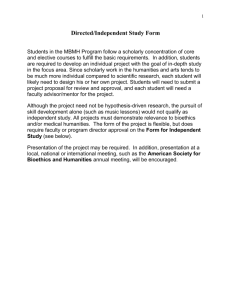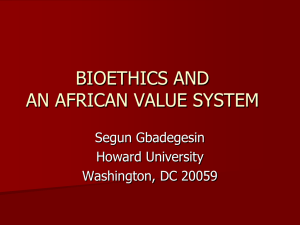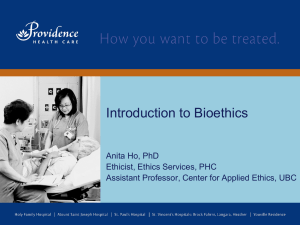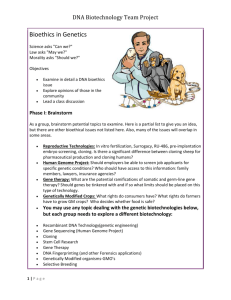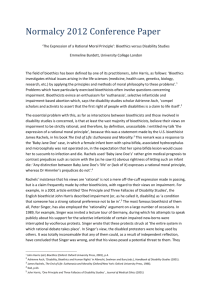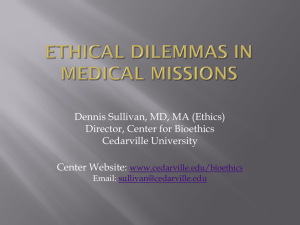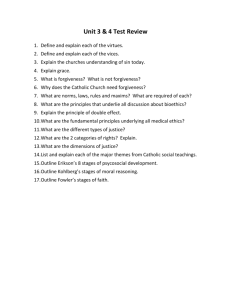Policy Review no. 159 (February 1, 2010) The Limits of Bioethics
advertisement
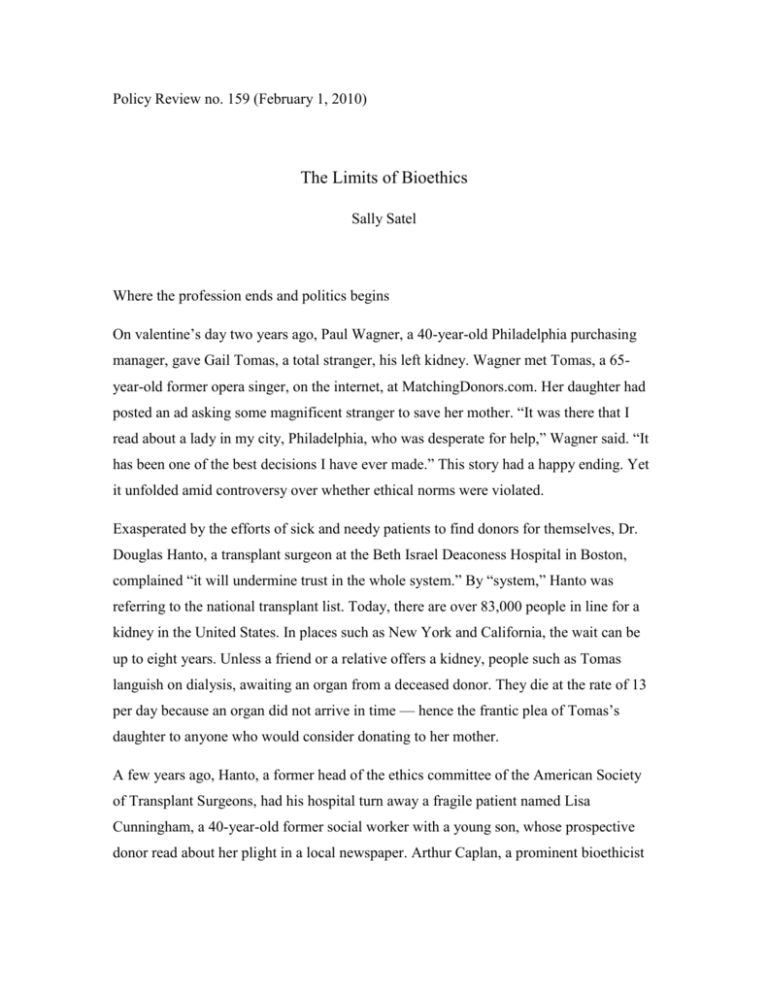
Policy Review no. 159 (February 1, 2010) The Limits of Bioethics Sally Satel Where the profession ends and politics begins On valentine’s day two years ago, Paul Wagner, a 40-year-old Philadelphia purchasing manager, gave Gail Tomas, a total stranger, his left kidney. Wagner met Tomas, a 65year-old former opera singer, on the internet, at MatchingDonors.com. Her daughter had posted an ad asking some magnificent stranger to save her mother. “It was there that I read about a lady in my city, Philadelphia, who was desperate for help,” Wagner said. “It has been one of the best decisions I have ever made.” This story had a happy ending. Yet it unfolded amid controversy over whether ethical norms were violated. Exasperated by the efforts of sick and needy patients to find donors for themselves, Dr. Douglas Hanto, a transplant surgeon at the Beth Israel Deaconess Hospital in Boston, complained “it will undermine trust in the whole system.” By “system,” Hanto was referring to the national transplant list. Today, there are over 83,000 people in line for a kidney in the United States. In places such as New York and California, the wait can be up to eight years. Unless a friend or a relative offers a kidney, people such as Tomas languish on dialysis, awaiting an organ from a deceased donor. They die at the rate of 13 per day because an organ did not arrive in time — hence the frantic plea of Tomas’s daughter to anyone who would consider donating to her mother. A few years ago, Hanto, a former head of the ethics committee of the American Society of Transplant Surgeons, had his hospital turn away a fragile patient named Lisa Cunningham, a 40-year-old former social worker with a young son, whose prospective donor read about her plight in a local newspaper. Arthur Caplan, a prominent bioethicist 2 at the University of Pennsylvania, condemned donor solicitation online as “an outbreak of impatience combined with a me-first attitude,” he told a reporter. Unless a friend or a relative offers a kidney, people such as Tomas languish on dialysis, awaiting an organ from a deceased donor. Me first? Cunningham was not snatching a kidney away from someone else. Except for the story about her, there would have been no offer in the first place. Moreover, every socalled Good Samaritan donor who gives to someone like Cunningham or Tomas removes them from the queue, and so others move up a slot. No one is harmed while someone is saved. Caplan is a bioethicist; his titles imply an expertise in ethics. Hanto served as the chair of the Ethics Committee at the American Society of Transplant Surgeons. Yet what are we to make of their willingness to issue life-and-death pronouncements involving other people? Well, we know a few things about them. First, that they share an absolutist approach to egalitarianism: If all cannot benefit, then none should benefit. Second, as ethicists they presume to know how despairing patients should conduct their private affairs. And third, they appear to have few qualms about conveying to desperately ill people a message of hopelessness: Be passive, dying patients — wait your turn and take no initiative to save your own life. Does being a bioethicist entitle one to any such moral authority, edifying the rest of us about right and wrong? Is this what society should expect of its “ethics experts”? The proper relationship between experts and citizens is a question of longstanding interest to sociologists and social critics. In the case of bioethicists, the nature of the subject about which they claim authority is up for debate. Traditionally, they have focused on the controversies surrounding biomedical technology, such as cloning, sex selection, in vitro fertilization, nanotechnology, research ethics, organ allocation, and so on. Now experts are calling for involvement in policy. Renee Fox and Judith P. Swazey, senior scholars who have studied the sociology and history of bioethics, urge a focus on “inequalities in health and in access to health care in America.” The field is too “narrowly American-ocentric,” they write in their 2008 book Observing Bioethics; it should become 3 “more centrally and deeply involved with [global] suffering and issues of social justice.” In his new book The Future of Bioethics, Howard Brody, a physician and philosopher at the University of Texas Medical Branch, instructs bioethicists to gauge success by asking themselves if they are “speaking truth to power.” These prescriptions presume a moral authority that bioethicists cannot properly claim. Origins Where did bioethicists come from? Ethical conundrums in medicine long predated the creation of the field now known as bioethics. In his respected book The Birth of Bioethics, Albert R. Jonsen, a moral theologian and bioethicist, dates the origin of bioethics as a distinct discipline to 1947, the year that 23 physicians were convicted of war crimes during the Nuremberg tribunal. Others believe the field grew out of postwar technological capabilities that intensified the already vexing dilemmas about human control over life and death. Medical controversies over care for the terminally ill, reproductive technology, genetic manipulation, and organ transplantation drew the attention of Catholic theologians and other religious scholars in the 1950s and 1960s. In concert with philosophically inclined physicians and scientists, they began to apply moral theory to modern medical controversies. The exploration of these issues soon became more secularized as historians, philosophers, anthropologists, legal scholars, and others joined in. At the same time it became clear that as technology enhanced physicians’ therapeutic powers, it increased the range of interventions that patients could undergo and the vulnerability that came from not understanding the risks of those interventions. This recognition brought questions about doctors’ duty to inform patients about the treatments prescribed, the alternatives available, the patient’s prognosis, and the right to refuse care. A backlash against medical paternalism that was already underway in the 1960s began to attract academics who were engaged in the civil rights and antiwar movements and harbored a keen distrust of institutions; they trained their sights on resetting the balance of power between physicians and patients. 4 As ethical quandaries multiplied and demanded attention, it was perhaps inevitable that a specialized group of professionals — the bioethicists — would emerge to meet the task. In an impressive burst of institution-building that was funded by both the federal government and private philanthropies, three bioethics think tanks sprang up between 1969 and 1971: the Hastings Center, in upstate New York; the now defunct Society for Health and Human Values, in Philadelphia; and the Kennedy Institute of Ethics at Georgetown University, a Jesuit institute, in Washington. Populated by physicians, legal scholars, philosophers, historians, and humanists, their agendas coalesced around cuttingedge issues such as genetic testing, organ transplants, in vitro fertilization, neonatal intensive care units, euthanasia, and other conundrums surrounding death and dying. And when, in the 1970s, research scandals at Willowbrook and Tuskegee erupted, research ethics and regulatory oversight were added to the bioethics portfolio. Inhabitants of the ivory tower were eager to make themselves relevant by applying theory to real-world problems. According to Daniel Callahan, one of the founders of the Hastings Center, he and his colleagues wanted to give philosophy “some social bite, some ‘relevance.’” In 1982, in an article called “How Medicine Saved the Life of Ethics,” the philosopher and historian Stephen Toulmin argued that the imperatives of medicine enabled moral philosophy to avoid the academic sidelines. And there is no question that, in some cases, physicians themselves turned to theologians and moral philosophers for help. Today, bioethics has an impressive institutional footprint. Major universities house bioethics centers that offer a plethora of programs: intensive immersion courses, certificate programs, master’s and doctoral degree programs. The field has several peerreviewed journals and a major professional organization. Bioethicists teach medical students and undergraduates; they serve on hospital ethics committees and on research review boards. In many hospitals bioethicists are “on call” to offer guidance on issues such as the mental competence of patients and whether certain life-prolonging treatments should be initiated or withdrawn. Some are regularly sought out by the media, others consult for pharmaceutical companies, and a few even serve as expert witnesses in courts 5 of law. In the public policy arena, bioethicists are appointed to presidential commissions and state and federal task forces that formulate guidelines and advise politicians. Since 1970, the year in which the term “bioethics” was coined by Sargent Shriver, the institutional base of bioethics has flourished. The swift rate of growth alone makes the field itself perhaps as interesting as the problems it addresses. As the bioethicist Carl Elliot has pointed out, every sector of society has its moral dimensions, “yet in no other sphere of our lives [but medicine] has ethics been so thoroughly professionalized . . . it is worth stepping back and noting just how unusual this really is.” No wonder bioethics has become a subject of study in its own right. A wide-open field Bioethics today is a field with widely divergent understandings of itself. In meetings of the American Society for Bioethics and Humanities (asbh), which is the major professional organization for bioethicists, and in journal symposia, participants try to come to terms with the question of what kind of enterprise bioethics is. Is it a field of scholarly inquiry, a learned profession, a consultancy, a form of policymaking or activism, an oversight apparatus that monitors researchers and physicians, a discourse, a project, or a collection of questions or issues? What training should a bioethicist receive? Should the field take stands on mainstream political issues, such as the war in Iraq, the crisis in Darfur, Abu Ghraib? Are bioethicists excessively beholden to the institutions that they serve? When I spoke in 2006 at the annual meeting of the asbh on the assigned topic of whether the organization should take political positions — I said no — the reception I received was chilly indeed. This was a question that the society itself had been debating for years. During the q and a, almost all the bioethicists who asked questions contested my view that professional groups damage their credibility when they pronounce on issues outside of their expertise. Au contraire, they said; as experts in ethical matters, who better than us to opine? I remember feeling sympathy for the leadership of the asbh, which has to 6 accommodate these competing views, and I admired the officers for inviting me in the first place and for airing the society’s internal disagreements openly. Finding the “right” moral answer — assuming for a moment one exists — is not the business of applied ethics. Is it politically desirable for society to credit a designated group called “bioethicists” with expertise in resolving the most difficult moral questions? If so, what is it that gives ethicists a more legitimate claim to wisdom about right and wrong than the rest of us? The matter of ethical expertise — what it looks like, who can claim it — is a profound one. The place of bioethics in the academy, in the clinical realm, and in society turns on it. For most of us, the very idea of the “right” answer to a complex moral dilemma seems absurd on its face. After all, its derivation depends upon which moral theory one favors: deontological, consequentialist, natural law, situational, and so on. By no means does this negate the possibility, let alone the importance, of serious moral reflection, but such analyses may be too lost in the foundational questions to be of much everyday use. And, of course, many bioethicists rely on their own philosophical biases. So, for example, when bioethicists condemn organ donor solicitation with the argument that it gives unfair advantage to some or violates human dignity, we must ask what makes them sufficiently sure of their view to impose it on others? Finding the “right” moral answer — assuming for a moment one exists — is not the business of applied ethics. So what can bioethics offer? What is its technical expertise? The answer comes into focus when we think of applied ethics as a deliberative process, one that concerns itself with how to determine what ought to be done rather than to make a concrete determination per se. For example, when an expert in bioethics approaches a problem, such as an end-of-life decision, he brings a deep knowledge of the cultural history of that controversy, including the conceptual schemes that have been used to resolve it and relevant legal decisions. This allows him to draw analogies to current situations. While hovering above the fray the bioethicist objectively delineates value conflicts, lays out the assumptions behind different positions, evaluates the soundness of arguments according to standard rules of logic, and reflects upon the potential 7 consequences of various courses of action. Mostly, he imparts this analysis to the doctors or administrators who enlisted his advice. However, when working directly with patients, the task is typically one of helping them or their loved ones reach consensus about endof-life decisions or course of treatment. Ultimately, the bioethicist presents his analysis to the designated decision-maker — typically a physician or an administrator — who is accountable to his patients and his employer. Bioethicists should not advocate for patients or physicians or hospitals; they should advocate for disinterested moral deliberation. Nor should they mistake consensus, which is required in order to take action, for the discovery of moral truth. The role of the bioethicist, then, should be to illuminate debates, not to settle them. In the parlance of medicine, they do not have prescribing privileges. Though many bioethicists disavow the mantle of moral authority that the professionalization of ethics implies, many others, alas, do not. Ask almost any hospital physician about this and you will get, in reliable sequence, an eye roll, a sigh, and then an earful of anecdotes about swaggering bioethicists posing as arbiters of right and wrong (“Wizards of Oughts,” as the critic Giles Scofield put it). In the media, the coverage of almost any biomedical controversy is sure to contain a quotation from a bioethicist with oracular pretensions. The message is clear: Anyone who disagrees with me is thoughtless or unethical. Such arrogance discomfits ethical bioethicists as well. Erik Parens of the Hastings Center, located just outside of New York City, regrets the popular view of ethicist as “priggish or foolish enough to lay claim to how other people should lead their lives.” Fed up with Homo bioethicus, Carl Elliott of the University of Minnesota has remarked that “Many people working in and around bioethics wince if someone called them a ‘bioethicist’ . . . Some resist the aura of professionalism and moral expertise that the term bioethics seems to imply. Others are just embarrassed by the incivility and glibness of our public spokespeople. Others just don’t want to be viewed as the ethics police.” 8 Bioethics and social justice Bioethicists like ruth macklin of the Albert Einstein College of Medicine would have bioethics adopt an aggressive pursuit of social justice. “As a liberal, humanitarian bioethicist,” she told interviewers, “I acknowledge that my chief concern is in striving for greater social justice within and among societies, and reducing disparities in health, wealth, and other resources among populations in the world.” Howard Brody opines that the future agenda of bioethics “ought to be concerned with power disparities.” These may be noble aspirations, but one must ask what particular authority or skill bioethicists possess that qualifies them to solve global health problems, let alone economic ones. Achieving social justice in health is a complex task that requires the forging of a meaningful universal agreement on what health care should be like and what kind of scheme should dictate the national and transnational allocation of medical resources. Lest Americans be accused of bioethical imperialism, they will need to be part of a consensus involving countries whose fundamental views of justice, fairness, and basic human rights may differ dramatically from our own and from one another. The origin of the current crisis of purpose, identity, and expertise in bioethics stems in large part from its being a derivative enterprise. It is unclear what the field of bioethics can add in the way of unique scholarship, practical wisdom, or ethical reflection that is not already being applied today, for better or worse, by experts in international development, global health economics, and political theory. Granted, there might be a role for the dispassionate articulation of moral options, but as Fox and Swazey portray them, bioethicists who seek a global stage sound more like activists intent on changing the world. Moreover, so many of the world’s tragic circumstances do not need subtle moral clarification. They result from unjust institutions and corrupt leaders, and they require state and international action in the political and in some cases even the military realms. Displacing oppressive regimes and establishing the rule of law are no jobs for a bioethicist. The question for bioethics, then, is whether such a moral crusade is an appropriate mission for the field. Or, as the philosopher and bioethicist Jonathan Moreno has rightly asked, “Can a scholarly field retain its 9 intellectual legitimacy, both internally and in the eyes of the public, when some of its core topics seem to be matters of ideology, rather than, or at least as much as, expertise?” The origin of the current crisis of purpose, identity, and expertise in bioethics stems in large part from its being a derivative enterprise. During the 1960s and early 1970s, bioethics was less a distinct field than a collegial network of scholars and learned professionals who shared a mutual interest in applying moral theory to medical quandaries. These physicians, legal theorists, philosophers, historians, anthropologists, and sociologists were members of established academic disciplines with distinct bodies of knowledge, with time-honored theories and methods of inquiry. They brought those intellectual traditions to bear on questions of value-conflict within medicine. But when the zone of intersecting interests promoted itself into a primary, semi-autonomous field of its own, in much the same way that women’s studies or black studies did, it became more and more estranged from the rigorous scholarly disciplines that spawned it. Now many students aspire to become “bioethicists” without any other disciplinary background. “Conservative” bioethics Though professional bioethicists may not agree, they tend to close ranks when outsiders presume to make ethical claims. Fox and Swazey describe how mainstream bioethics — which they consider to be “essentially synonymous [with] liberal bioethics” — reacted with tribal animus to the ascendancy of conservative bioethics during the Bush administration. A defining moment of the bioethics culture wars was August 9, 2001. On that day President Bush announced federal funding, with restrictions, for human embryonic stem cell research and named Leon Kass, a vocal critic of embryonic stem cell cloning, as director of a new President’s Council on Bioethics. During its tenure, which ended in June 2009, the Council elicited full-throated denunciations by many in the academy. Among the most vocal was Alta Charo, a legal 10 scholar and bioethicist from the University of Wisconsin (recently named by the Obama Administration to serve as a senior advisor at the Food and Drug Administration) who has referred to Kass’s reign as “the Endarkenment.” More dramatically, when Kass presented the keynote at the asbh in 2004, the atmosphere in the lecture room crackled with hostility and some in the audience stood with their backs to him as he spoke. The implication is clear: The conservative agenda is essentially inhospitable to scientific progress and, by extension, to the patients who could benefit from its fruits. Recall when Dolly, the cloned Scottish ewe, stepped daintily into the public square in 1997. For the most part, mainstream bioethicists were exhilarated by the therapeutic promise she represented, whereas their right-leaning colleagues saw Dolly’s creation as a threat to the sanctity of life and the beginning of a program that could well end in cloning designer children. The right and the left have a profoundly different understanding of what is at stake; and the rift between them, it is safe to say, is unbridgeable. So deft are some conservative bioethicists at conjuring apocalyptic visions of a posthuman future that the journalist Will Saletan has characterized them as “standing athwart history, sighing ‘Oy.’” He has a point. To be sure, they sigh with erudition and with eloquence. Should conservative bioethicists — or any bioethicist, for that matter — counsel us on reasons for vigilance? Yes, but too often they warn us not to make any progress at all. There is an irony here. For all the deference that conservative bioethics pays to the implicit wisdom of the ages, it rarely mines the recent past for lessons. Instead of concentrating on the ancients, why not also study the history of in vitro fertilization, paid egg donation, and surrogate motherhood to learn about cultural resistance and adaptation to such practices? Even better, why not consider earlier practices that were deemed repugnant in their day but are now unexceptionable? The list of these moral apocalypses that never were is a distinguished one: vaccination, anesthesia, blood transfusions, life insurance, artificial insemination. Perhaps the systematic analysis of these practices holds little interest for conservative bioethicists because most of society now regards them as nonissues. Or more likely, they regard an objective assessment as irrelevant given their convictions that 11 certain practices pose such an affront to human dignity that they should not be pursued at all, no matter how much good can come of them. And what about politics? To be fair, mainstream bioethicists are correct when they say that conservative bioethicists often have a political agenda. But so do they, making their assertion that President Bush’s Council on Bioethics was too partisan and homogeneous — “a council of clones,” as Arthur Caplan remarked — amusing indeed. Having attended several council meetings myself, I can attest to its diversity of views and its careful deliberation. In the end, yes, the “Oys” had it but, no surprise, other bioethics commissions have displayed their own slant. They were “chaired by liberals, staffed by liberals, [with] overwhelmingly liberal members,” according to Daniel Callahan of the Hastings Center. Yet, as Callahan says, “they received hardly any criticism at all.” When bioethicists swim in the same ideological waters as the administrations they serve, their likeminded colleagues find little to complain about — but a bias may still lurk. The human subject No discussion of bioethics is complete without a discussion of human subject research. It is through the regulatory reach of ethics oversight that we see how deeply institutionalized bioethics has penetrated medicine. In 1974, in response to the revelations surrounding the Tuskegee Syphilis Study, Congress passed the National Research Act. It mandated the creation of institutional review boards, or irbs, to ensure that the benefits of research outweighed the risks and that individuals know those risks before consenting to become a subject. All human subject research conducted in medical schools, universities, and federal agencies must be approved by irbs. Today many irbs are hidebound bureaucracies. The informed consent documents that subjects must read and sign can run to dozens of pages. To spare themselves suffocation by red tape, researchers sometimes abandon studies altogether. Changing a single word in a consent form at the request of an irb can entail a months-long wait for approval after resubmission. Out of zealous concern for subjects’ privacy, some irbs require that raw data, including tapes and transcripts, be destroyed a few years after collection. For 12 investigators who wish to replicate or to extend the original work, this is an irretrievable loss of information. Amid burdensome paperwork requirements and nitpicky objections to even the most innocuous interventions, projects are often held up for months. This costs medical schools considerable amounts of money and, as in the case of cancer drug trials, it surely costs actual lives. Efforts to assure informed consent and subject autonomy often veer into smothering paternalism. Consider the complaints of mental health researchers in the wake of September 11<. Their timely access to victims was thwarted by irbs concerned that subjects would be “re-traumatized” by filling out a questionnaire or undergoing an interview. Along these lines, many irbs spend hours deliberating over whether subjects will be “coerced” into participating in a study if offered a token gratuity of, say, $25. More serious cases have involved the refusal to allow parents to enroll their terminally ill children in studies. In the pioneering days of liver transplants, for example, some bioethicists said that parents of dying infants should not be allowed to give them a lifesaving segment of their own liver. The reason? No parent would refuse the opportunity to save his own child’s life — thus, he would effectively be “coerced” into doing so — and so the option should not exist at all. Based on this dubious logic, the power of decision would have been taken from the parents. Someone else knew better. What’s more, as doctors have long observed, some parents do indeed refuse, especially if they have other children for whom they must remain healthy and not risk major surgery. The scenario echoes the time in the mid-1990s when ethicists urged physicians to withhold genetic test results from women with a high risk of breast cancer. The knowledge, they believed, was just too dangerous for the women to handle. And yet, the field of bioethics considers the institutionalization of research ethics to be among its greatest accomplishments. Having attended anniversary conferences commemorating the Belmont Report, a document that in 1979 set forth the basic principles of human research, Fox and Swazey portray themselves as bemused to hear bioethicists praising Belmont as “near-canonical,” having “changed the world,” and having been “consecrated” by its impact. To be sure, nobody denies the need for research 13 oversight. But at many institutions the pendulum surely has swung too far in the direction of vigilance. Relentless scrutiny and seemingly capricious restriction have fostered mutual distrust between reviewers and researchers, making legitimate regulation more difficult and encouraging gaming by investigators. Priorities for bioethicists When bioethicists speak, who listens? When geologists weigh in on global warming, attention must be paid. After all, they are experts in climate science. When bioethicists put a full-page ad in the New York Times urging the passage of universal health care, as they did in 1994, what kind of expertise do they bring to bear? Citizens interested in the debate are sufficiently versed in its moral dimensions; “experts” are not required to tell them what is and is not ethical. Nor does the repudiation of Matchingdonors.com hold sway with vulnerable patients, the people who love them, or most of the doctors who want to save them. They embrace their own moral imperative: to minimize suffering through the unparalleled kindness of strangers. At their best, bioethicists are scholars who study the intellectual and social history of value controversies in medicine and biotechnology. They can teach us about the technical and cultural antecedents of modern debates and show us how to engage in disciplined moral inquiry. They are skilled at drawing conceptual maps of the dilemma at hand while enumerating various ways to resolve it. In these ways, bioethicists have much to offer. But beyond this, their value is mainly cosmetic or bureaucratic. When called upon by politicians, their main task is to neutralize explosive issues or to provide ethical cover for decisions that have already been made. When physicians summon them, it is mostly to mediate disputes between patients, staff, and family members regarding end-of-life decisions. The media tap bioethicists for high-minded sound bites. In hospitals and in governmental agencies, they man the regulatory ramparts. It is hard to gauge how much impact organized bioethics has had on society. If the activist wing closed up shop and the pundits went home, it is doubtful they would be missed. But one hopes that at least its scholarly and didactic entities will live on. With 14 our growing technical capacity to manipulate our biology and thus our destiny, biomedical dilemmas will certainly increase in number and in difficulty, and they will require as much thoughtful attention as they can get. But social justice should be left to others — to the rest of us. The more bioethics promotes an agenda of social or economic reform, the more it betrays itself to be politics by other means. Sally Satel, a practicing psychiatrist, is a resident scholar at the American Enterprise Institute. She is the editor, most recently, of When Altruism Isn’t Enough: The Case for Compensating Kidney Donors (AEI Press, 2009).
